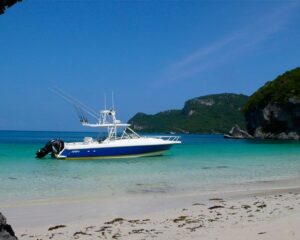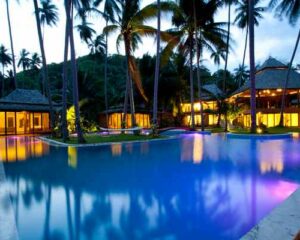Koh Samui lies 35 kilometers off Suratthani (one of the major cities in southern Thailand) and about 700 kilometers south of Bangkok. It is the 3rd largest island in Thailand and was discovered several hundred years ago by fishermen and sea traders whilst sailing through the Gulf of Thailand. Samui, with its many sheltered bays, offered a welcome sanctuary from the tropical storms. Early Chinese and Malay settlers marveled at the island’s beauty and abundance, and there are those that believe the name is derived from the word “saboey”, which means “safe haven” in the Chinese tongue. “Koh” is the Thai word for “island”. Maps of the island date as far back as the 17th century but there is very little documented history because most of the knowledge was passed down through the generations by word of mouth. The island’s hinterland consists of forested hills of limestone and granite whilst the shoreline is made up of countless beaches and bays.
Samui is 21 kilometers at its widest point and 25 at its longest with one major road, which circumvents the island. Until 1940, there were no roads or vehicles on Koh Samui. People moved around the island on foot or followed the coastline by boat. For example, to go from Maenam to Lamai, it took several hours of walking through the mountainous jungle, and going there and back in the same day was impossible.
The first communities that developed here survived mainly by the sea, then later by the planting of crops, which flourished in the warm tropical climate. Tropical fruit became an important export industry and even today Samui is known throughout Thailand for succulent fruits such as “Lang Saad”, a small round fruit similar to a lychee, and the infamous durian with its pungent yellow flesh.
Although the palm tree has become the symbol of Samui, it was not until relatively recently that coconuts became the most prolific fruit on the island. Over the years farmers slowly turned the island into a huge coconut and rubber plantation and, with the crops fetching a good price, Thai people from the mainland began to arrive hoping to benefit from the island’s economy. Samui boasts more varieties of coconut than anywhere else in the world, although sadly an infestation of beetles now threatens many of these majestic tropical trees. These days’ coconuts are mainly collected and processed for the production of copra.
In the early days it could take 7 or 8 hours to reach Samui by boat from Suratthani so many of those that came to the island decided to stay and build a home, living alongside their foreign neighbors in what was to become a strong and independent community. Although Buddhism established itself as the principle religion, a small Muslim population also flourished and local spirits are still worshipped today in a tolerant blend of beliefs that adds to the island’s unique cultural appeal.
Agriculture remained the main source of income for Samui people throughout the next 20 years until the first foreign travelers began to arrive in the early 70s. Young, adventurous backpackers from Europe then established Samui as a favorite location and before long the local people were providing basic accommodation, food and services to their newfound visitors. Samui became something of a hippie paradise during the 70s and 80s, the laid-back lifestyle and natural surroundings attracting those in search of a real escape. Bungalows sprang up all over the island, and slowly the infrastructure began to develop with a more regular ferry service from the mainland and then finally an airport.
Bangkok Airways is privately owned by Dr Prasert Prasarttong-Osoth and he opened the first Samui airport in April 1989. Bangkok Airways now offers direct flights between the island and Phuket, Hong Kong and Singapore. The airline made its first foray into jet aircraft in 2000, when it started adding Boeing 717s to its fleet. Up until then, Bangkok Airways had flown propeller-driven aircraft, primarily the ATR-72. The new Samui airport was officially opened in July 2008.
The last 10 years have brought the biggest changes in the entire history of the island. However, even due to many building projects, the island manages to retain much of its charm as quaint local villages and coconut plantations are still very much in evidence.





